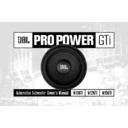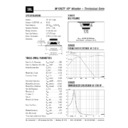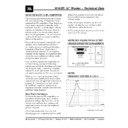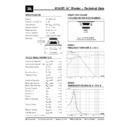JBL W10 GTi User Manual / Operation Manual ▷ View online
PRO POWER
TM
Automotive Subwoofer Owner’s Manual
W10GTi W12GTi W15GTi
Thank you for choosing a JBL GTi Series
subwoofer. GTi Series subwoofers are
designed to provide maximum sound
output in a variety of enclosure types
while maintaining the superb sound quality
associated with JBL. To ensure the best
subwoofer performance, we strongly
recommend that installation be entrusted
to a qualified professional. Although
these instructions explain how to install a
GTi Series subwoofer in a general sense,
they don’t show the specific installation
procedures that may be required for your
particular vehicle. If you feel you don’t have
the necessary tools or experience, don’t
attempt the installation yourself; rather,
ask your authorized JBL dealer about
professional-installation options.
subwoofer. GTi Series subwoofers are
designed to provide maximum sound
output in a variety of enclosure types
while maintaining the superb sound quality
associated with JBL. To ensure the best
subwoofer performance, we strongly
recommend that installation be entrusted
to a qualified professional. Although
these instructions explain how to install a
GTi Series subwoofer in a general sense,
they don’t show the specific installation
procedures that may be required for your
particular vehicle. If you feel you don’t have
the necessary tools or experience, don’t
attempt the installation yourself; rather,
ask your authorized JBL dealer about
professional-installation options.
Warning: Playing loud music in an
automobile can hinder your ability to hear
traffic, as well as permanently damage your
hearing. We recommend listening at low
levels while driving. JBL accepts no liability
for hearing loss, bodily injury or property
damage resulting from use or misuse of
this product.
automobile can hinder your ability to hear
traffic, as well as permanently damage your
hearing. We recommend listening at low
levels while driving. JBL accepts no liability
for hearing loss, bodily injury or property
damage resulting from use or misuse of
this product.
Your Car and Bass Reproduction
Depending on the size of the vehicle’s
interior listening space, reproduced
frequencies below 80Hz may be boosted
by nearly 12dB per octave as frequency
decreases. This effect, commonly known
as transfer function or cabin gain, plays
an important role in defining the in-car
frequency response of your subwoofer.
It is displayed graphically, along with
freespace response, on the enclosed
data sheet for your GTi subwoofer.
Depending on the size of the vehicle’s
interior listening space, reproduced
frequencies below 80Hz may be boosted
by nearly 12dB per octave as frequency
decreases. This effect, commonly known
as transfer function or cabin gain, plays
an important role in defining the in-car
frequency response of your subwoofer.
It is displayed graphically, along with
freespace response, on the enclosed
data sheet for your GTi subwoofer.
Power-Handling Limitations
The power-handling capacity of any
subwoofer is related to the excursion
limit of its suspension and its ability to
dissipate heat. A speaker reaches its
excursion-limited power-handling capacity
when its suspension is stretched to its
limit. The excursion curve shown on the
Enclosure Design Sheet (included with
your woofer) displays cone excursion at
the input power level required to drive
the woofer to maximum linear excursion
(X
The power-handling capacity of any
subwoofer is related to the excursion
limit of its suspension and its ability to
dissipate heat. A speaker reaches its
excursion-limited power-handling capacity
when its suspension is stretched to its
limit. The excursion curve shown on the
Enclosure Design Sheet (included with
your woofer) displays cone excursion at
the input power level required to drive
the woofer to maximum linear excursion
(X
max
). The input power shown may
be used as instantaneous input only.
Thermal power handling is determined by
the amount of heat that may be dissipated
by the driver’s voice coil. The power-
handling rating assigned to your GTi Series
subwoofer is its thermal-power-handling
rating. This rating assumes a clean
(unclipped) signal. A clipped waveform
has much higher average power, due to
the longer duty cycle at the top and bottom
of the waveform; it will heat the woofer’s
voice coil faster than a clean signal and
may damage the voice coil. A square wave
has a 100% duty cycle and is extremely
dangerous for any speaker. Audible
distortion in the output of your woofer
is an indication that your amplifier may
be clipping, which could damage your
speakers over time.
the amount of heat that may be dissipated
by the driver’s voice coil. The power-
handling rating assigned to your GTi Series
subwoofer is its thermal-power-handling
rating. This rating assumes a clean
(unclipped) signal. A clipped waveform
has much higher average power, due to
the longer duty cycle at the top and bottom
of the waveform; it will heat the woofer’s
voice coil faster than a clean signal and
may damage the voice coil. A square wave
has a 100% duty cycle and is extremely
dangerous for any speaker. Audible
distortion in the output of your woofer
is an indication that your amplifier may
be clipping, which could damage your
speakers over time.
02
The Official Brand of Live Music
Choosing an Enclosure
GTi Series subwoofers are optimized to
perform best in small sealed, vented and
bandpass enclosures. While infinite-baffle
mounting of GTi Series subs is possible,
power handling will be compromised since
there will be no enclosed volume of air
to help the speaker’s suspension control
the motion of the woofer’s cone. For this
reason, we do not recommend infinite-
baffle mounting for high-power applications.
GTi Series subwoofers are optimized to
perform best in small sealed, vented and
bandpass enclosures. While infinite-baffle
mounting of GTi Series subs is possible,
power handling will be compromised since
there will be no enclosed volume of air
to help the speaker’s suspension control
the motion of the woofer’s cone. For this
reason, we do not recommend infinite-
baffle mounting for high-power applications.
You should choose the enclosure you’ll use
based on the type of music you listen to,
how much amplifier power you’ll use to
drive the subwoofer, and how much space
inside the vehicle you can devote to a
subwoofer enclosure. If you’ll be using your
GTi Series subwoofer for SPL competition,
please see the document titled “GTi as SPL
Competition Subwoofers” (included with
your woofer).
based on the type of music you listen to,
how much amplifier power you’ll use to
drive the subwoofer, and how much space
inside the vehicle you can devote to a
subwoofer enclosure. If you’ll be using your
GTi Series subwoofer for SPL competition,
please see the document titled “GTi as SPL
Competition Subwoofers” (included with
your woofer).
Because a sealed enclosure provides the
most control over the woofer’s movement, a
woofer mounted in a sealed enclosure will
handle more power at low frequencies than
a woofer mounted in another enclosure
type. Sealed enclosures provide more
accurate sonic reproduction than other
enclosure types, so they are well suited
to all types of music. Sealed-enclosure
construction is straightforward. An
optimum sealed enclosure is always smaller
than other types of enclosures that are
optimized for a particular speaker, so they
require the least space inside the vehicle.
most control over the woofer’s movement, a
woofer mounted in a sealed enclosure will
handle more power at low frequencies than
a woofer mounted in another enclosure
type. Sealed enclosures provide more
accurate sonic reproduction than other
enclosure types, so they are well suited
to all types of music. Sealed-enclosure
construction is straightforward. An
optimum sealed enclosure is always smaller
than other types of enclosures that are
optimized for a particular speaker, so they
require the least space inside the vehicle.
Vented enclosures provide better efficiency
in the 40Hz – 60Hz range, but this
efficiency comes at the expense of sound
output in the lowest octave (below 40Hz)
and at the expense of some control and
power handling below box tuning. If you
are using a small amplifier, a vented box
will provide more bass output from less
power. Vented enclosures are also well
suited to a variety of music types. Because
vented enclosures require the volume
of the enclosure and the size of the port
to have a specific relationship with the
characteristics of the woofer, the enclosure
must be built exactly to the specifications
provided. If you wish to use a vented
enclosure, we strongly recommend having
your authorized JBL dealer build it; or
verify that your design is correct if you
wish to build it yourself. An optimum
vented enclosure is always larger than
the optimum sealed box for the same
woofer, and will require more space
inside the vehicle.
in the 40Hz – 60Hz range, but this
efficiency comes at the expense of sound
output in the lowest octave (below 40Hz)
and at the expense of some control and
power handling below box tuning. If you
are using a small amplifier, a vented box
will provide more bass output from less
power. Vented enclosures are also well
suited to a variety of music types. Because
vented enclosures require the volume
of the enclosure and the size of the port
to have a specific relationship with the
characteristics of the woofer, the enclosure
must be built exactly to the specifications
provided. If you wish to use a vented
enclosure, we strongly recommend having
your authorized JBL dealer build it; or
verify that your design is correct if you
wish to build it yourself. An optimum
vented enclosure is always larger than
the optimum sealed box for the same
woofer, and will require more space
inside the vehicle.
Bandpass enclosures can provide the
greatest output available from any amplifier
and subwoofer combination – at the
expense of sonic accuracy. If sheer SPL
(sound pressure level) is what you desire
most, choose a vented or bandpass
enclosure. Bandpass enclosure design is
very tricky and the aid of a computer and
enclosure design software is necessary if
you wish to design the enclosure yourself.
Like a vented enclosure, a bandpass
enclosure must be built exactly to the
specifications provided. Bandpass
enclosures can be quite large and may
require a lot of space inside your vehicle.
greatest output available from any amplifier
and subwoofer combination – at the
expense of sonic accuracy. If sheer SPL
(sound pressure level) is what you desire
most, choose a vented or bandpass
enclosure. Bandpass enclosure design is
very tricky and the aid of a computer and
enclosure design software is necessary if
you wish to design the enclosure yourself.
Like a vented enclosure, a bandpass
enclosure must be built exactly to the
specifications provided. Bandpass
enclosures can be quite large and may
require a lot of space inside your vehicle.
03
PRO POWER
TM
Enclosure Construction
Please observe the following suggestions
when building an enclosure for GTi Series
subwoofers.
1. Choose an enclosure design from the
Please observe the following suggestions
when building an enclosure for GTi Series
subwoofers.
1. Choose an enclosure design from the
Enclosure Design Sheet included with
your subwoofer.
your subwoofer.
2. Use at least 3/4" (19mm) MDF (medium
density fiberboard) or marine birch
plywood to build the enclosure.
Enclosures for 12" and larger
subwoofers and smaller woofers driven
by high-power amplifiers should be
constructed using 1" (25mm) material.
plywood to build the enclosure.
Enclosures for 12" and larger
subwoofers and smaller woofers driven
by high-power amplifiers should be
constructed using 1" (25mm) material.
3. Join pieces of wood with glue and
screws; do not use nails. Once the box
has been tested, seal all joints inside
the box with silicone caulk.
has been tested, seal all joints inside
the box with silicone caulk.
4. Fill the enclosure with damping material
(dacron, fiberglass insulation or
long-fiber wool) according to the design
you have chosen from the Enclosure
Design Sheet. “0% fill” indicates
that no damping material
should be used; “50% fill”
indicates that all interior walls
except the baffle should be
lined with 1" thick damping
material, and “100% fill”
indicates that the box should
be loosely stuffed with
damping material.
long-fiber wool) according to the design
you have chosen from the Enclosure
Design Sheet. “0% fill” indicates
that no damping material
should be used; “50% fill”
indicates that all interior walls
except the baffle should be
lined with 1" thick damping
material, and “100% fill”
indicates that the box should
be loosely stuffed with
damping material.
5. Use PVC or ABS plastic pipe for ports.
Keep in mind that the openings at either
end of the port must be at least one port
diameter away from any obstruction.
end of the port must be at least one port
diameter away from any obstruction.
6. Use the 10/24" machine screws and
T-nuts provided to mount the woofer to
the baffle. See Figure 1.
the baffle. See Figure 1.
Figure 1. Mounting the GTi woofer
in its enclosure
Dual Coil Versus Differential Drive
®
(patent pending)
Conventional dual-voice-coil woofers use
a pair of voice coils “interwound” on the
former and centered in the magnetic gap.
The two coils may be connected in series
or parallel in order to maximize an
amplifier’s output power. Both coils drive
the cone forward and rearward. X
Conventional dual-voice-coil woofers use
a pair of voice coils “interwound” on the
former and centered in the magnetic gap.
The two coils may be connected in series
or parallel in order to maximize an
amplifier’s output power. Both coils drive
the cone forward and rearward. X
max
(one-way-linear) is determined by the
amount of voice coil exposed above
and below the top plate. A conventional
voice coil is made up of several layers of
windings, each transferring heat to the
winding next to it until the heat is finally
dissipated by the outside layer through
the top plate, magnet and backplate. This
arrangement is inefficient, and results in
low thermal power handling. See Figure 2.
amount of voice coil exposed above
and below the top plate. A conventional
voice coil is made up of several layers of
windings, each transferring heat to the
winding next to it until the heat is finally
dissipated by the outside layer through
the top plate, magnet and backplate. This
arrangement is inefficient, and results in
low thermal power handling. See Figure 2.
Figure 2. Conventional dual-voice-coil design
JBL GTi Series subwoofers employ
Differential Drive, a technology developed
by JBL Professional. Differential Drive
employs two voice coils positioned at
opposite ends of the former, each
suspended in a separate magnetic gap.
These two coils may be connected in series
or parallel, like a conventional DVC woofer,
to maximize an amplifier’s output power.
Both coils MUST be connected to the
amplifier in correct polarity! At low power,
both voice coils drive the woofer’s cone,
and any motor nonlinearities are cancelled
by the out-of-phase coils and gaps. As
power input increases so that one coil rides
completely out of its gap, force is still
applied to the cone by the other coil. At
extremely high power, each coil will enter
Differential Drive, a technology developed
by JBL Professional. Differential Drive
employs two voice coils positioned at
opposite ends of the former, each
suspended in a separate magnetic gap.
These two coils may be connected in series
or parallel, like a conventional DVC woofer,
to maximize an amplifier’s output power.
Both coils MUST be connected to the
amplifier in correct polarity! At low power,
both voice coils drive the woofer’s cone,
and any motor nonlinearities are cancelled
by the out-of-phase coils and gaps. As
power input increases so that one coil rides
completely out of its gap, force is still
applied to the cone by the other coil. At
extremely high power, each coil will enter
T-NUTS
(PROVIDED)
10/24"
SCREWS
(PROVIDED)
TOP PLATE
POLE PIECE / BACKPLATE
CONE
SPIDER
BOTH COILS
DRIVE CONE
FORWARD
AND
REARWARD
MAGNET
OVERHANG DETERMINES
X
max
04
The Official Brand of Live Music
Display




